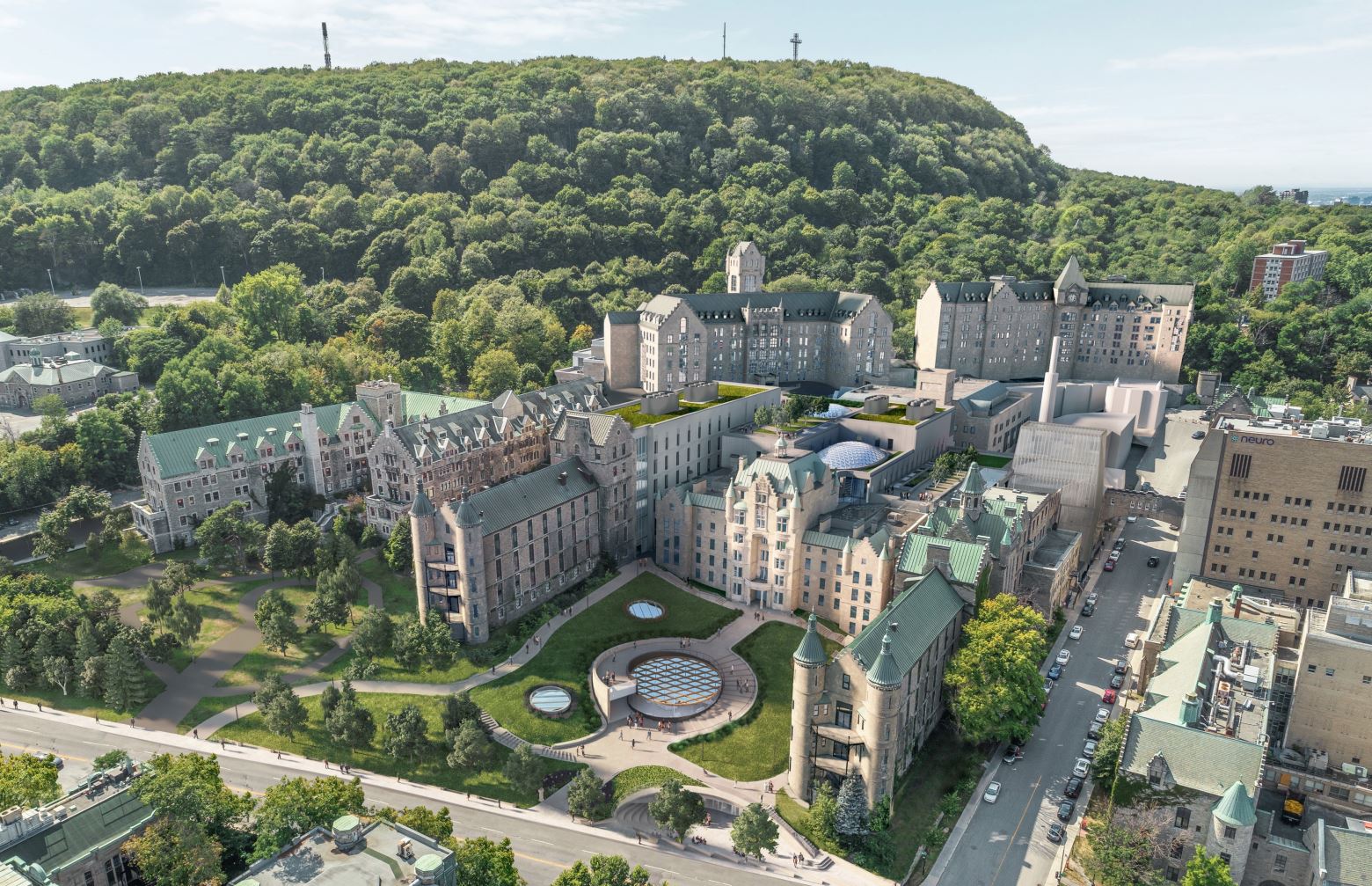
“We shape our buildings, and afterwards our buildings shape us.”
– Winston Churchill, Oct. 28, 1943
The architects of McGill University’s New Vic Project have won a Canadian Architectural Award of Excellence for their design. The honour for Diamond Schmitt/Lemay Michaud Architectes was announced Friday Dec. 1, 2023 by Canadian Architect, the profession’s national magazine of record.
The project, on part of the site of the former Royal Victoria Hospital, will comprise restored Scottish baronial heritage buildings and new construction. It will bring together scientists doing research on an array of sustainability topics and experts on the shaping and implementation of public policy.
The award jurors praised Diamond Schmitt/Lemay Michaud Architectes for having done a superb job.
“Without compromising the integrity of the historic buildings or overly downplaying the new addition, the old buildings become much more accessible and will be given a new life,” a juror wrote. “Brought much closer to the public street, the new entrance is immediately welcoming and brings you into a series of sunlit and generous volumes, despite being largely underground.”
Design of the building, which is expected to open in early 2029, is now 100-per-cent complete. There will be several types of labs, offices, classrooms, a library, cafeteria and many spaces for working collaboratively. As well, the complex will feature such sustainable technologies as geothermal energy and green roofs, and access to Mount Royal.
Transformational project
Pierre Major, Executive Director, New Vic Project, emphasized that Diamond Schmitt/Lemay Michaud Architectes have proven themselves ideal partners for McGill, bringing to life the University’s vision for the New Vic.
“They’ve really delivered a transformational project,” he said.
“It’s allowing the mountain to flow further into the city and the city to connect back to the mountain,” Major explained. “It will allow the community to walk through the site and appreciate what’s going on there.”
What’s “going on there” will be the bringing to life a part of the university’s Strategic Academic Plan, which emphasizes well the central role of sustainability in the university’s mission.
Creating new academic opportunities
“We’re not just moving people, we’re creating new opportunities with this building,” says Bruce Lennox, Dean of Science and Academic Design Lead for the project.
In the past, the “notion of segregating intellectual activity by discipline was baked into buildings,” says Christopher Manfredi, Provost and Vice-Principal (Academic), who is also executive steward of the project.
The New Vic is about “rethinking, reimagining and reinventing” not only how intellectual activities are organized, he says, but how we inhabit the planet, how we live in cities and how we use materials.
“The idea of creating a vision with that intention is about having disciplines collide to tackle difficult problems is really exciting, and not common in the Canadian education landscape at all,” says Christopher Buddle, Associate Provost (Teaching and Academic Planning) and Academic Lead, New Vic Project.
To understand the importance of a collaborative relationship between scientists and public policy experts, one need only think back to the COVID-19 pandemic, Lennox says. Whether it was in setting guidelines for social distancing or in vaccine rollout, it was essential for public policy to be informed by science. At the same time, scientists’ work could only have a societal impact via public policy.
“Just about everything in the sustainability spectrum actually is executed by policy at the end of the day,” he says.
The result will be the world’s largest site of concentration of sustainability research and its relationship to policy, Lennox notes. The New Vic will physically be home to about 150 professors, and another 900 or so graduate students and post-doctoral researchers. Research labs are being designed for flexibility, avoiding over-specialization. As well, there will be 760 seats in active learning classrooms that will be part of the central classroom booking system. This will bring thousands of McGill students to the building, as will the other facilities.
Indigenous presence
The design will include architectural elements that reflect the continued presence and influence of Indigenous people and culture on this territory and at McGill.
The Indigenous influence will go beyond representation, however.
“The transfer of Indigenous knowledge into the sustainability research sector is only just beginning, but it’s so profound, (for example) the insights that Indigenous knowledge brings into the concepts of biodiversity,” Lennox says. “What we need to do, of course, is create an ongoing dialogue.”
‘An intellectual space for anyone interested in sustainability and public policy’
Which units and faculty will relocate to the New Vic largely remains to be determined, says Buddle.
But regardless of who makes the physical move, “it is an intellectual space for anyone interested in sustainability and public policy,” he says. For example, researchers based at Macdonald Campus will still have their labs at Mac, but “they will have lots of opportunity for meaningful scholarly connections to the New Vic.”
Another way the project will transform McGill is by offering an opportunity to reuse the space vacated on the lower campus.
“The released space is as important as the new space,” says Buddle. “We also have opportunities to do things differently in the other buildings, too.”
Below, view renditions of the award-winning design of the New Vic Project
